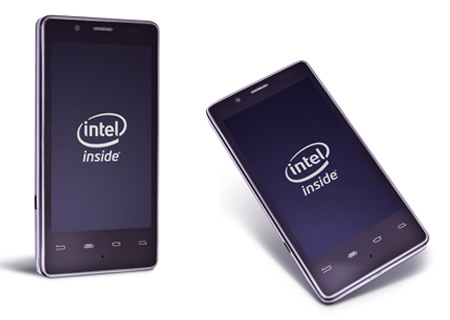Intel inside: x86 smartphones in all pockets of the country?
 Intel x86 architecture will soon appear on the smartphones around us. Or at least Intel wants it. But is it worth it not to sleep because of this?
Intel x86 architecture will soon appear on the smartphones around us. Or at least Intel wants it. But is it worth it not to sleep because of this?x86 is an abbreviation for Intel's proprietary CPU instruction set. It appeared on the market in the late 70s and completely dominates among desktops and laptops. Even Apple was not able to resist x86 and switched to its desktop Macs from PowerPC architecture to x86 in 2006.
Currently, x86 seems to capture all aspects of computing. But relatively small British company ARM has undermined the influence of Intel in the mobile market. Its processor architecture has been optimized for low power consumption and limited space - in other words, ideally optimized for smartphones.
')
Intel x86 processors were more powerful than any ARM offerings. But more powerful means more volatile. And until recently, Intel did not have any proposals that could meet the tiny power consumption that is required for smartphones.
Intel's first step
In 2008, the company launched the first Atom chips, a new generation of x86, designed to be significantly more energy efficient than any previous x86 processors. The real battle for smartphones began precisely with this event.
Rewind to 2012 and see that Intel has finally released the first x86 smartphones running on the Medfield version of Atom. In Britain, the first x86 smartphone will be Orange Santa Clara. Lenovo (with Lenovo K800) and Motorola are also almost ready to start selling x86 models.
The first sign that the project did not come from Intel is very easy - time. It took almost two years more to bring Atom processors into smartphones than planned. Moreover, Intel promises fairly good, but not phenomenal performance. However, the plus is that performance and power consumption are competitive compared to existing ARM processors.
The first benchmarks of reference smartphones from Intel show that Medfield is actually faster than the iPhone 4S and Samsung Galaxy S II, despite the fact that it is currently a single-core processor.
The problem with Intel is that these phones work on relatively old dual-core ARM processors. By the time x86 smartphones truly enter the market this year, there will already be more powerful offers from competitors, such as the Qualcomm Snapdragon S4 Krait, a new chip in the widespread Snapdragon series, and they will no doubt be faster than even a dual-core Atom. Krait, it seems, will not yield in speed in a dual-core format, and in addition, the processor will be with four cores.
At the same time, there are other quad-core ARM competitors, including Nvidia Tegra 3, which is already running HTC One X. Intel promises the Medfield dual-core version, but given the company's slowness in launching the first single-core version, it’s hardly worth holding your breath .
Operating Systems?
Of course, this is only the hardware part of the equation. The software part is no less important. The good news is that the popular Android mobile operating system has already been ported to x86. The bad news is that existing applications may not be compatible with Intel phones.
Intel expects that 75% of existing Android applications will work fine. The problem is the remaining 25%. The more demanding the application to the resources, the more likely it will not work. All with good graphics, including most games, most likely just will not start.
Not such a big job to recompile such applications. But the main idea is to make such applications work through software translation. Intel aims for 90% compatibility. How much and how well these applications will work and ensure the success of x86 processors on the smartphone field.
What about graphics?
Another problem for Intel is that graphics are increasingly becoming a key factor in the ultra mobile segment. When Apple updated its iPad, it left the central processor in the same way - however, it doubled the performance of the graphics subsystem.
A similar trend can be observed in smartphones - graphics performance becomes more important than the screen resolution, graphics become more complex and the games are more advanced. But if there is something that Intel did not succeed in, then this is the graphics. In fact, Intel just bought a graphic design for Medfield Atom processors.
Until Intel comes out with something really its own (and there is not even evidence that the company is trying), it is unlikely that it will offer a better graphic design than other processors for smartphones.
Best production
If this doesn't sound very optimistic, there is one reason to think that Intel will still be able to offer you a super-smartphone. The fact is that Intel production is the best among all computer processors. The company has the most advanced manufacturing process and it can create the smallest transistors.
Right now Intel is not making Atom processors over the most advanced 22nm process. But when it shrinks to 14 nm around the beginning of 2014, the company claims that Atom will get it one of the first. If this happens, then obviously, Intel will be able to offer more computing and graphics cores, increase the clock frequency, outrun competitors in terms of battery life, or offer such thinnest smartphones as they haven’t been.
There are many ifs. But for a couple of years, the fastest smartphones with the longest running time and in the thinnest form factor can carry Intel processors inside.
Source: https://habr.com/ru/post/142969/
All Articles